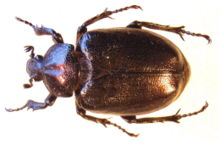| Osmoderma eremita | |
|---|---|
 | |
| Adult female | |
 | |
| Larva | |
| Scientific classification | |
| Kingdom: | |
| Phylum: | |
| Class: | |
| Order: | |
| Family: | |
| Genus: | |
| Species: | O. eremita |
| Binomial name | |
| Osmoderma eremita (Scopoli, 1763) | |
Osmoderma eremita, the hermit beetle or Russian leather beetle,[2] is a species of European beetle in the family Scarabaeidae. Adults reach between 28 and 32 mm in length.[3]
Distribution
O. eremita can be found everywhere in Europe, except for The United Kingdom, Iceland, Ireland, Malta, Portugal, and San Marino.[4]
Larvae
The larvae develop in hollow trees. Oak is the preferred kind of tree, but the larvae may develop in any tree species with suitable hollows.[2] Due to extensive scientific research, O. eremita is the most well known insect species associated with ancient or hollow trees. For instance, research has addressed the beetles' dispersal biology,[5] population dynamics,[6] and chemical communication.[7] Trained conservation detection dogs are being used in monitoring larvae in Italy.[8]
Conservation status
Due to habitat loss and fragmentation, the species has decreased all over its distribution range. For this reason the species is protected in most European countries, and has been given the highest priority according to the EU's Habitats Directive.[2]
References
- ^ Nieto A.; et al. (2010). "Osmoderma eremita". IUCN Red List of Threatened Species. 2010. Retrieved 2016-08-02.
- ^ a b c "Hermit beetle (Osmoderma eremita)". ARKive. Archived from the original on April 14, 2013. Retrieved April 3, 2010.
- ^ http://www.catedu.es/arablogs/blog.php?id_blog=1556&id_articulo=79542
- ^ "Osmoderma eremita (Scopoli, 1763)". Fauna Europaea. Retrieved 27 June 2012.
- ^ Hedin, Jonas (2008). "Restricted dispersal in a flying beetle assessed by telemetry" (PDF). Biodiversity and Conservation. 17 (3): 675–684. doi:10.1007/s10531-007-9299-7.
- ^ Ranius, Thomas (2001). "Constancy and asynchrony of Osmoderma eremita populations in tree hollows" (PDF). Oecologia. 126 (2): 208–215. doi:10.1007/s004420000515. PMID 28547619.
- ^ Larsson, Mattias (2003). "The characteristic odour of Osmoderma eremita (Coleoptera: Scarabaeidae) identified as a male-released pheromone". Journal of Chemical Ecology. 29 (3): 575–587. doi:10.1023/A:1022850704500. PMID 12757320.
- ^ Mosconi, Fabio; Campanaro, Alessandro; Carpaneto, Giuseppe Maria; Chiari, Stefano; Hardersen, Sönke; Mancini, Emiliano; Maurizi, Emanuela; Sabatelli, Simone; Zauli, Agnese; Mason, Franco; Audisio, Paolo (2017). "Training of a dog for the monitoring of Osmoderma eremita". Nature Conservation. Pensoft. 20: 237–264. doi:10.3897/natureconservation.20.12688. ISSN 1314-3301.
